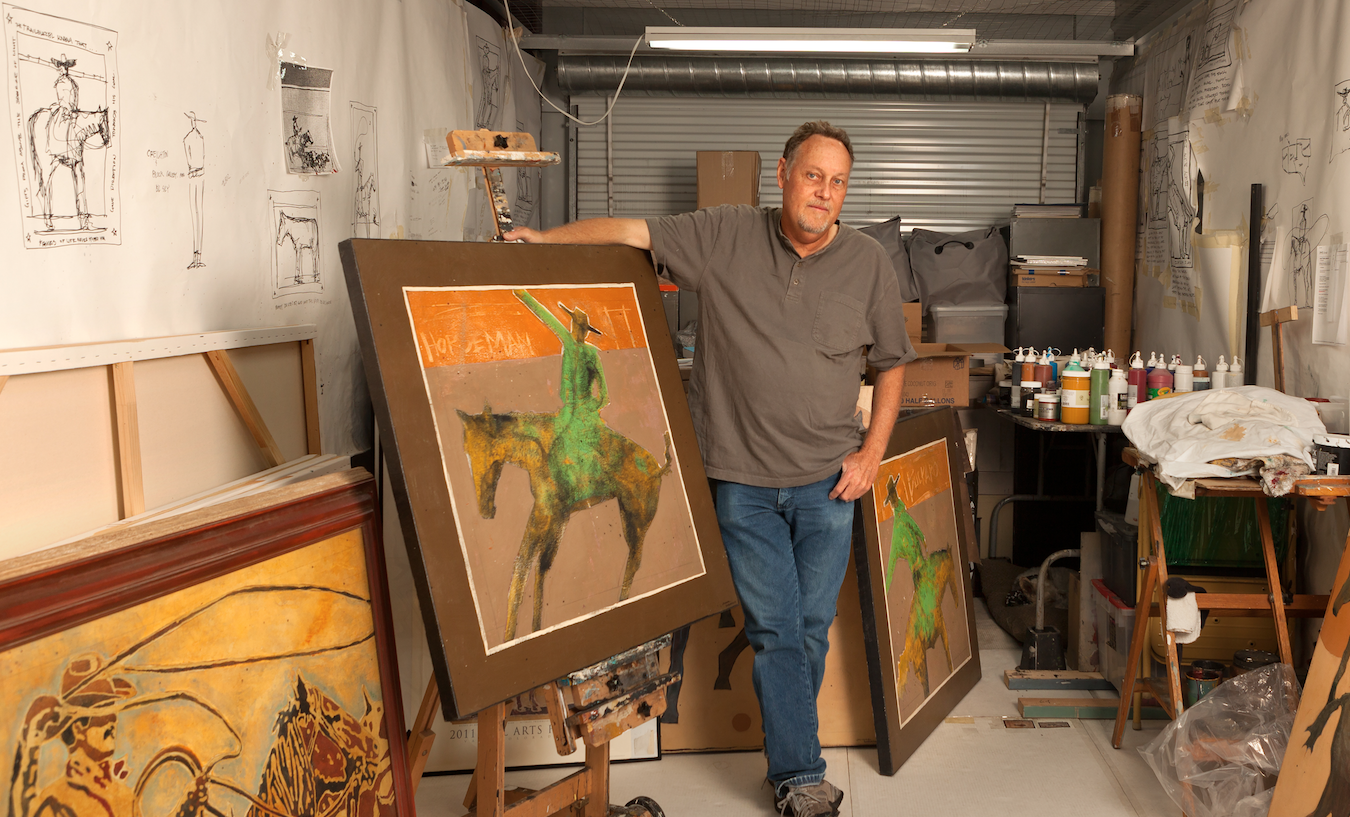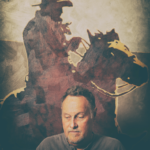Writer Shannon Severson
Photography by Scott Baxter
[dropcap]I[/dropcap]n the early 1960s, on a 320-acre farm outside Knob Noster, Missouri, Anne Fay Swearngin cared for her grandson while doing the laundry. Without indoor plumbing, it was a time-intensive task and she feared that, unless the boy was thoroughly occupied, he might wander off and fall into the farm’s 160-foot-deep well. She handed him a bit of chalk and some crayons.
“Mikey, do me some artwork,” she said, gently directing him to an 8-foot by 8-foot poured concrete slab in a nearby enclosed porch.
“That concrete slab was my first canvas,” says contemporary painter Michael Swearngin. “My time on that farm, with my grandmother, Anne Fay and grandfather, Lowell, formed my early love for art and taught me the heritage of the cattleman and rancher.
“My grandmother would always say to me, ‘You’re my artist.’ She encouraged me from the start.”
That confidence inspired him to continue to pursue what, for many years, was his secondary occupation. With stints as a South Texas land surveyor during the oil boom of the 1980s, co-owner of a screen printing business with his brother, and accomplished graphic artist, he took classes in his spare time and painted each night. It was many years before painting took its rightful place at the center of his life, but Anne Fay lived to see the fulfillment of his promising talent.
At age 92, she attended one of Swearngin’s Missouri shows. It’s a memory he still treasures.
As a military kid, he didn’t get to spend his entire youth on the farm. When his father, Charles, was assigned to duty in Europe for six years, Swearngin seized the opportunity to learn all he could from the family’s travels.
By age 14, he had visited 27 different countries and began painting. His use of color and texture, as well as his contemporary style, was heavily influenced by those experiences. Closer to home, he credits his grandfather Lowell with instilling his deep connection with the land and lore of the American West, which remains the inspiration for his subjects today.
His leap to becoming a full-time fine artist came about completely by chance on a snowy evening in Kansas City in 1994. A massive storm caused him to take an alternate route home from his graphic arts job, where he saw a sign for Joan Cawley Gallery’s catalog distribution house. The name rang a bell from the print shops and galleries he’d visited over the years.
“Joan Cawley Gallery ended up being my first gallery, and I was with her for 23 years,” says Swearngin. “It’s also what ultimately brought me to Arizona. In 1997, I took time off from my graphic arts job to take part in the Knickerbocker Artists Show in Scottsdale. The people I met as a result of that show were heavily influential in guiding me toward where I am now.”
When Joan Cawley’s Santa Fe Gallery closed in 1998, Swearngin moved to show in her Scottsdale location and was soon a featured artist for the Scottsdale Symphony Orchestra’s Silver Anniversary.
“My experience is reminiscent of the stories in Malcolm Gladwell’s Outliers,” says Swearngin. “When I look back at my career, I was in the right place at the right time. It was a combination of raw gifts, opportunity and divine intervention.
Another twist thrust him into the limelight when two pieces, Horse—Red, White and Blue, and Rugged Spirit were published by Cawley, unbeknownst to him, for a special showing at her New York gallery in December 2001. Cawley’s goal was to bring art to a city that was still reeling from the September 11 attacks. The fine art print of Horse—Red, White and Blue was then selected for the 2002 New York Art Expo 9/11 tribute. A steady stream of one-man shows, awards and museum acquisitions followed as collectors fell in love with his contemporary take on classic Western subjects.
“The rest is history,” says Swearngin. “Horse—Red, White and Blue changed my life. I pinch myself because it’s a storybook tale. It’s what every artist dreams of having happen. It doesn’t make my work any better, but I was published nationwide and my art became more widely accessible.”
In Swearngin’s studio, his analytical side shows through in the many thumbnail-size drawings that cover the walls, storyboard-style. It’s akin to very high-end graffiti, as he takes ideas, sometimes from live sketches and often from his own photographs, to create conceptual series that will find their way to the larger canvas in time via acrylic and mixed media.
He begins with simple shapes, then adds underpainting and glazing. As layers of paint are added and adhesive frisket is stripped away, the effect of his subjects against stark backgrounds is dramatic.
Though the themes are similar, each series offers a different perspective.
His Abstract Cowboy series is comprised of sketches drawn in the negative. Some have what he terms a heat register effect, which is appropriate for images of horse and rider that are full of movement and seem to vibrate with energy.
He’s been working on his highly successful Blue Roan series for two years. It relies heavily on underpainting and glazing to accent clear white backgrounds with graphic, blue-hued subjects that may appear simple from a distance, but a closer look reveals tone-on-tone detail.
The Abstract Navajo Horses series features indigenous Navajo horses. Swearngin notes that their unique build has adapted in such a way that they are perfectly suited for survival in the rugged, high elevation ranges of northern Arizona’s Navajo reservation. His abstract style marries well with his life-long knowledge of livestock.
“It’s not so serious,” says Swearngin. “I want art to be fun. The purity comes from the of the soul of the artist, but there is a commercial aspect for the galleries of balancing the equation to present the essence of the artist in as pure a form as possible while finding what will sell. I try to stay pure to the work. I have to be willing to adjust and make changes when I decide something isn’t working quite right.”
Plenty is working very well for Swearngin. His paintings are featured across the western U.S., from Texas to Wyoming to Oregon. Here in Arizona, his work can be found at Xanadu Gallery in Scottsdale and Wilde Meyer Gallery in Tucson. Gallery owners note that his contemporary style is equally suited to traditional homes or sleek, modern settings.
“We watched Michael’s work for years and loved his unique perspective,” says Xanadu Gallery owner and proprietor, Jason Horejs. “We’re not a Western gallery. We have a lot of diversity in terms of what we’re showing, but we loved his outlook on the West—it’s modern West. When we learned that he was looking for a new gallery, we jumped at the chance to build a relationship with him. His approach lends itself to a wide range of potential collectors.”
This September, Swearngin’s work will be featured at the National Museum of Wildlife Art’s Western Visions exhibit in Jackson Hole, Wyoming. Locally, his art paintings can be seen at Xanadu Gallery and Stock and Stable Restaurant in Phoenix, and will be featured in the Sonoran Festival of Art Extravaganza. Studio visits can be arranged by appointment.
Meet the Artist
Sonoran Festival of Art Extravaganza
Friday–Sunday, March 9–11
10 a.m.–5 p.m.
Stagecoach Village
7100 E. Cave Creek Rd., Cave Creek
Free admission
480-575-6624










Comments by Admin